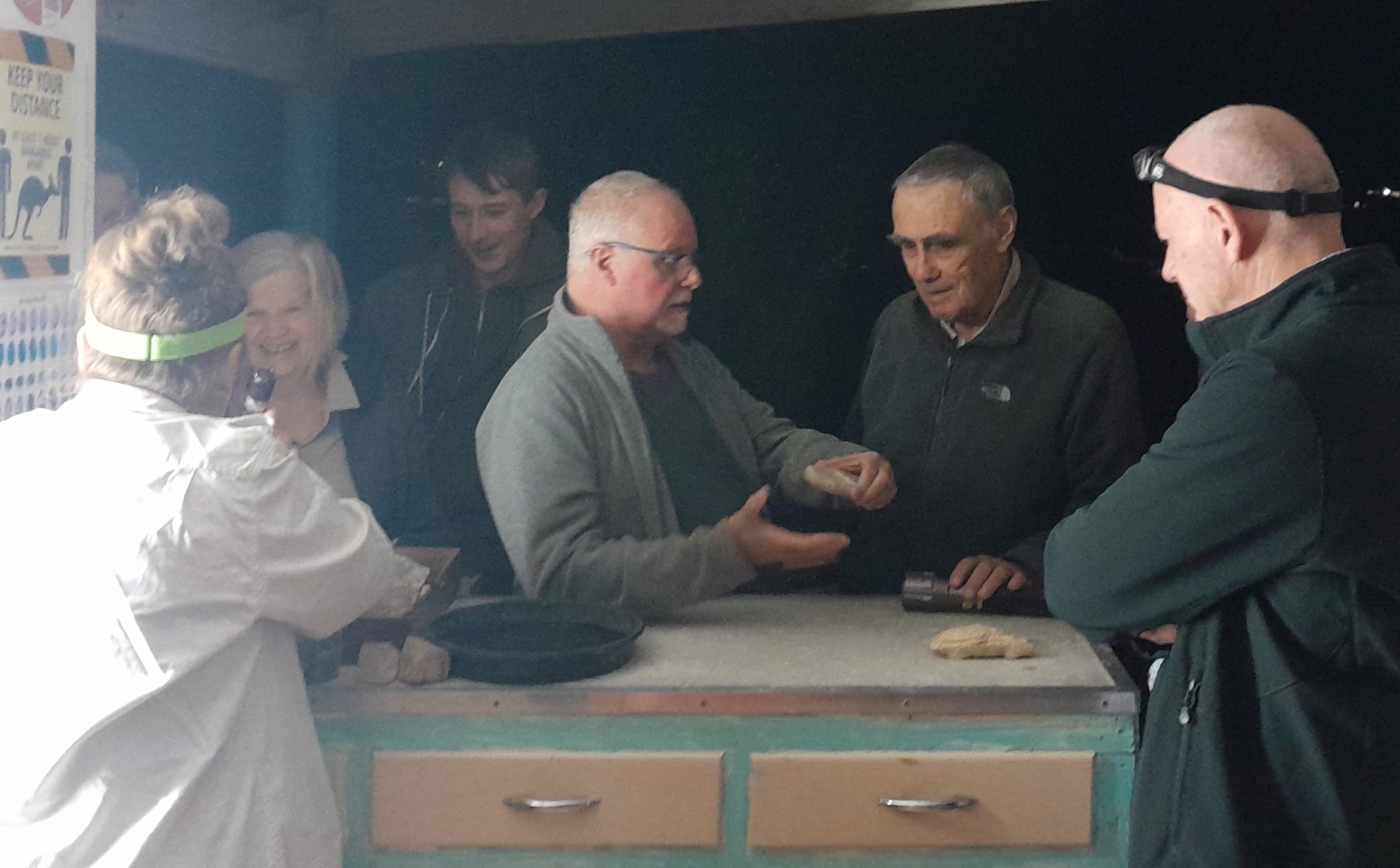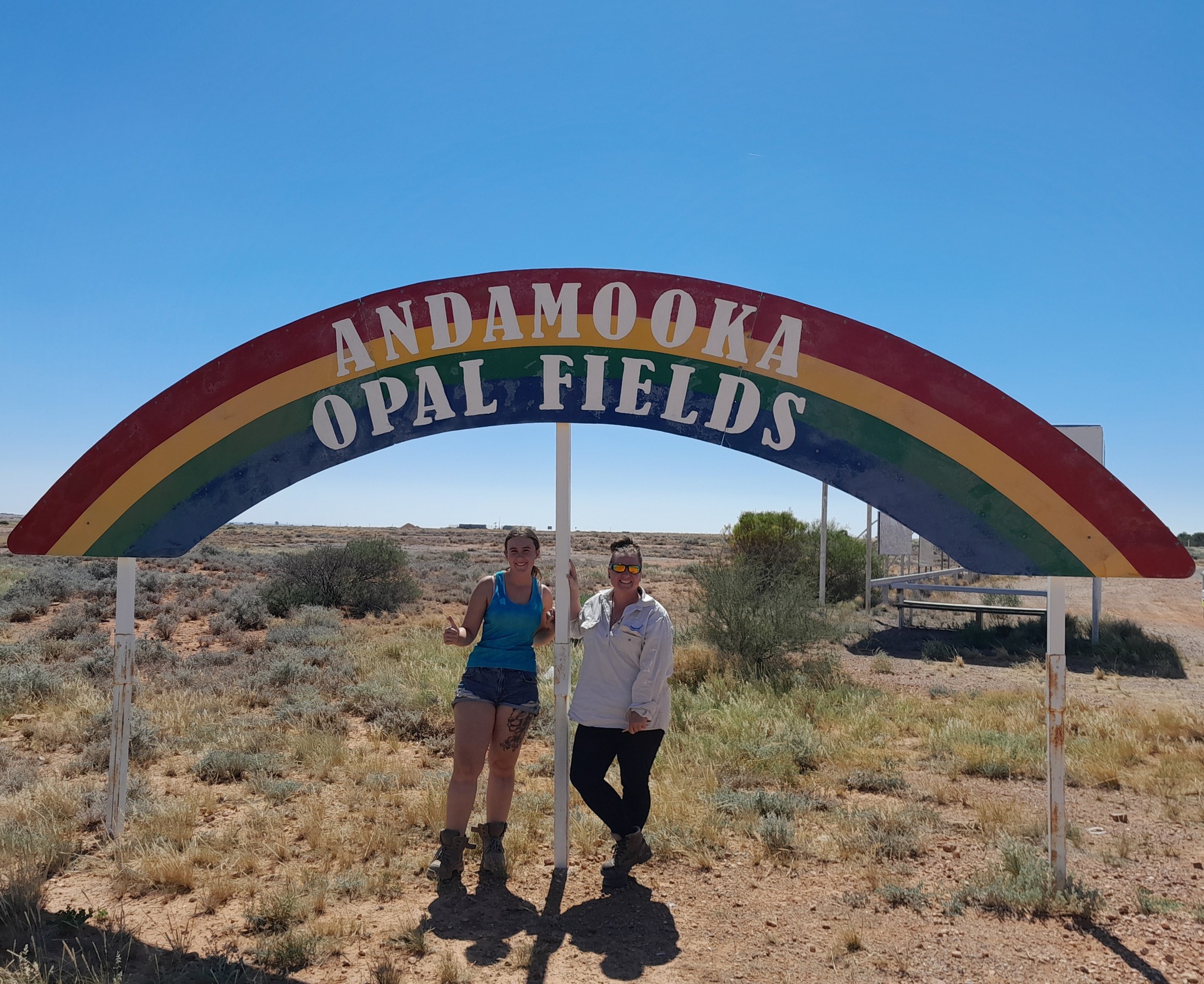
THE OPAL INDUSTRY IN AUSTRALIA 1950 by I. C. H. CROLL
(1) Historical.- The discovery of opal at Andamooka was made in 1930 by two boundary riders, Messrs. Brooks and Shepherd. The first miners
were Messrs. Treloar and Evans, who are stated to have worked a claim for several months for a return of £1,500 (Segnit, 1935). The first officially recorded production was valued at £962 and was obtained during 1933. In 1934 the value fell to £656, the lowest in the fifteen years for which records are available (Parkin, 1947). From 1939 to 1945-the war years-the value of production at Andamooka was consistently higher than that for Coober Pedy, which apparently suffered more from withdrawal of manpower. The highest value of production was £17,292 in 1946, and the aggregate to the end of that year £86,088. The geology of the field was described by Segnit (1935); in a later paper (1939) he published, without discussion, an amended geological map of the
area.
(2) Geographical Features.-The Andamooka field is situated at latitude 30°26′ south, longitude 137°10′ east, approximately 18 miles in a direct line and 30 miles by road north-north-east of Andamooka homestead, and about 8 miles west of the northern end of Lake Torrens. Access to the field is by rail from Adelaide to Pimba, and thence about 85 miles by road, via Arcoona
and Andamooka homesteads. The region is essentially a dissected tableland with gently undulating hills and low topographic relief. The surface of the tableland is about 600 feet above sea level near Andamooka homestead and has a gradual downward slope of about 300 feet in 40 miles in a northerly direction. The average rainfall is less than 6 inches per annum and the drainage channels flow only for short periods after heavy rains. Surface water is virtually absent and the opal miners and station population rely entirely on supplies obtained from bores, wells, and tanks. Numerous small clay pans, cane grass swamps and dry lagoons are scattered over the region and there are a few permanent lakes (e.g., Arcoona Lake). Low sandridges are a feature; although they are fixed by vegetation they are responsible for the devious tracks which have to be followed by cars. The field itself is of small extent and mining has been carried ‘On at eight or nine separate localities on the broad flat spurs formed by Opal Creek and its tributaries. Opal Creek is itself a tributary of Tea Tree Creek, which runs into Lake Torrens. The full extent of the field is not known, but according to the map prepared by Segnit (1939) it would be at least 4~ miles long ill’ an eastwest direction and approximately 3 miles wide. These may be regarded as the potential limits only, as actual operations have been carried out in less than half that area.
(3) Geological Features.-Precious opal occurs at Andamooka in a faulted outlier of Lower Cretaceous beds resting unconformably on quartzites, sandstones, and shales of Upper Pre-Cambrian age. The following sequence may be regarded as typical in the immediate vicinity of the field:-
- Superficial mantle of ferruginous and siliceous “gibbers.”
- Approximately 15 feet of dense quartzite and sandstone. This has been removed by erosion in most of the area but occurs as a capping.
on a small rise east-south-easterly of the German Gully Workings. Zone of cream siliceous shale with limonitic veins; thickness not known.
Cream or pale-pink siliceous clay and porous sandstone with gypsum in disseminated flakes or in horizontal seams. - Foraminifera have oeen recorded in the lower part (Crespm, 1948) and glacial erratics are said to occur (Segnit, 1935). Total thickness is approximately 55 feet, including the zone above.
Hard-band of brown sandstone.
seam of massive gypsum.
Band of coarse conglomerate and boulders up to 9 inch diameter.
White micaceous clay.
Opal occurs in the interstices of the conglomerate and as a surface film or
layer on the boulders, and it also occurs as seams within the clay
which underlies the conglomerate band. The conglomerate and clay
constitute the opal horizon, and the” hard band” and gypsum (where
present) serve to indicate the proximity of the horizon. The sequence
described above may be regarded as typical, but is not necessarily
continuous throughout the field. The total thickness of this zone
may be 5 feet but is variable.
A second boulder band is said to occur below the opal-bearing clay.
Approximately 20-25 feet of sandstone, clays, and conglomerates with
seams of gypsum and glacial erratics.
( ?) Jurassic micaceous sandstone. ‘
Upper Pre-Cambrian quartzite, sandstone, and shale exposed in the bed
of Opal Creek.
The beds above the (?) Jurassic micaceous sandstone are of Lower
Cretaceous age and have a total thickness of about 85 feet. They are undisturbed
by faulting except along the ‘southern edge of the outlier, where they have
been faulted against the Upper Pre-Cambrian quartzites and sandstone, The
opal workings near the fault are said to reveal some minor disturbance in the
Cretaceous beds, which are otherwise horizontally bedded.
(iv) Occurrence of Opal.-The opal-bearing horizon already described is
approximately 70 feet below ‘the plateau level and is therefore exposed on the
hillsides where the streams have cut below that level. The bed of Opal Creek
in the centre of the (field is about 100 feet below the general plateau level, and
the lowest workings are about 30 feet above the creek bed at this point. A
little work was d’One from adi’is, but the miners have a preference for shaft
~inking and this method ‘Of mining is used to the exclusion of others at the
present time.
The veins of opal may traverse the clay below the conglomerate at any
angle from horizontal to vertical, but! flat veins predominate. It is recorded
(Segnit, 1935) that the occurrence of opal in the Stevens Gully workings is
different from that in other parts of the field. Here the opal occurs as fine
veins in the large angular blocks of quartzite, and the conglomerate and waterworn boulders are very scarce or absent altogther. This is probably
connected with the proximity of the SteV’ens Gully workings to the fault which
marks the southern limit of the Cretaceous beds. Andamooka opal varies in colour and is generally darker than 1hat
obtained in Coober Pedy or White Cliffs. Some specimens are dark enough 10
c:ompare favourably with the Lightning Ridge black opal.
(v) General Remarks.-Living conditions at Andamooka are less attractive
than at Coober Pedy, although the miners are making a corporate attempt to
overcome this disability. Water supplies are drawn from wells, one of which
is fitted .with a windmill and small tank, but the supply is limited and barely
sufficient for essential needs. Postal facilities are available, the mail being
delivered once a week from Pimba, but telegraphic communication, via
Andamooka homestead, is subject to frequent interruptions. It is understood
that approval has been given for installation of a pedal wireless transceiver,
which will keep the field in touch with medical and other amenities. A general
store and a butcher’s shop are established.
Dwellings are varied in design, some being conventional timber frames
with weatherboard, sheet iron, hessian, or other material for walls, and
galvanized-iron Toofs, but !the majority are a type of semi-dugout. These are
constructed by digging an excavation into a hillside, constructing :the front
wall and portions of the side walls from the blocks of stone dugout, and using
rough timber, cane grass, and clay to frame and thatch the roof. These dwellings
have the advantage of being cooler than iron-roofed houses, but offer less
resistance to the high winds. Stone, brushwood, or cane grass windbreaks are
common where the surface buildings have been erected in exposed positions.
The 10cal Progress Committee is active in improving the social conditions of
the field. A small school building has been erected as a community effort and
a resident teacher has been provided by the Education Department. First
aid facilities are available and the Committee is endeavouring to have a landing
strip constructed so that the services of a Flying Doctor may be called on in
an emergency.
A few men on the field are engaged solely on cutting and polishing stones
and manufacturing doublets, but most of the opal won leaves the field in the
rough condition. Buyers visit the field from time to time and some of the
residents also buy small .quantities of opal for cutting locally or exporting.
One experienced miner is recognised as an expert valuer and his services in
this capacity are freely used by the other miners.
There appears to be scope for exploratory prospecting within easy reach of
the main camp, particularly to the east of the German Gully workings and to
the west of the Stevens Gully and Boundary Riders Hill workings. The
tendency of the miners to crowd together in areas which have been closely
worked is particularly marked at Andamooka, as also is the failure to make
the best use of the work involved in shaft sinking; the miners commonly
do not open out from the shaft to test the ground in the vicinity.


